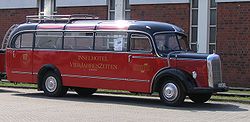Mercedes-Benz O 3500
| Mercedes Benz | |
|---|---|

Mercedes-Benz O 3500 |
|
| O 3500 | |
| Manufacturer | Daimler Benz |
| design type | City bus , intercity bus , coach |
| Production period | 1949-1955 |
| axes | 2 |
| engine | Diesel engine |
| power | 90 hp |
| length | 8.63 m |
| width | 2.42 m |
| height | 2.86 m |
| Seats | 22-37 |
| Standing room | 0-23 |
| successor | O 321 H |
| Similar models | Magirus-Deutz O. 3500 |
The Mercedes-Benz O 3500 was the first newly developed bus from Daimler-Benz AG in the post-war period and the first bus to be produced at the Mannheim plant. It was based on the Mercedes-Benz L 3500 truck presented at the same time with a diesel engine installed under a hood at the front . From the compact O 3500 is a whole family from Omnibus developed within a few years traveling , service bus and city buses. With 6049 units from December 1949 to the end of production in 1955, the O 3500 the most successful omnibus of its time.
City bus
The city bus had a compressed air operated sliding door at the front and a compressed air operated inner folding door at the rear. Behind the driver's seat there were four two-seater chairs each on the right and left, followed by a three-seater longitudinal bench above the wheel arches so that 22 passengers could sit. In the center aisle and the platform by the rear door there was a total of 23 standing places.
All-weather travel and overland buses
In contrast to the city bus, all-weather touring and intercity buses had hand-operated, hinged front doors. Compared to the intercity bus, the all-weather bus also had roof edge glazing and a sliding roof that was more than two and a half meters long and thus a 16 m² visible area.
The rear storage space behind the rear bench seat was accessible through a double door. The rear part of the body could be equipped with a roof rack to accommodate additional items of luggage.
In the interior there were twelve two-seater chairs with tubular steel seat frames, with the bench at the rear entrance being foldable. The finish was a bench for five people in the rear. Six single folding seats could be installed in the center aisle and a one or two-seat folding seat next to the driver , so that there was space for up to 37 passengers. All seats were covered with synthetic leather, headrests, center armrests, adjustable backrests, folding tables on the front seats and later even individual seats were available for an extra charge.
Furnishing
The bus had a driver's door. The safety equipment included a flashing light system , double windshield wipers, rear-view mirrors inside and outside, windows made of safety glass, a rear-wall window set up as an emergency exit, fire extinguisher and first-aid kit were placed within easy reach under the dashboard. A heating and ventilation system, sun visor, six ceiling lamps, footboard lamps with door contact and a buzzer system with two push buttons ensured the comfort. The driver's seat was adjustable lengthways and separated from the passenger compartment by a blind. A rotatable driver's seat that could be adjusted in all directions was available at an additional cost. The inside of the bus was equipped with a linoleum floor, the center aisle covered with non-slip rubber block mats, on the city bus the center aisle and platform were covered with wooden strips. In the interior, all wooden parts were stained or polished, the seat frames were painted in color and the metal fittings were bare. You could choose between a one- or two-tone exterior paintwork. The city bus had a sign box with three plug-in signs as standard, a sign box with a roller band was available for an extra charge .
engine
The six-cylinder pre-chamber diesel engine OM 312 with a displacement of 4.6 liters developed 90 hp. An oil cooler with temperature control was attached to the engine. Power was transmitted to the rear axle by a five-speed claw transmission. The engine-gearbox block was mounted on rubber.
Technical specifications
- Type: OM 312
- Number of cylinders: 6
- Bore: 90 mm
- Stroke: 120 mm
- Displacement: 4580 cm³
- Top speed: 82 km / h
- Standard fuel consumption: 14.8 liters = 12.6 kg / 100 km
- Output: 90 hp at 2800 rpm
chassis
The load-bearing chassis was designed to be lower than that of the truck, in favor of a low entry.
Technical specifications
- Front and rear track: 1700 mm
- Ground clearance: 250 mm
- Chassis weight: 2800 kg
- Maximum permissible total weight: 8500 kg
- Tires: 8.25–20
- Turning circle: 19.2 m
- Fuel tank capacity: 92 liters
